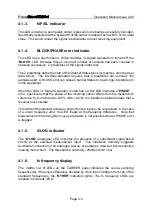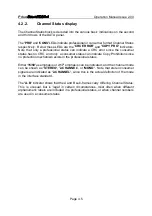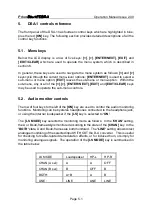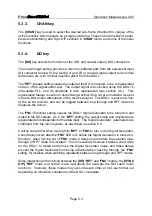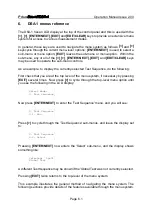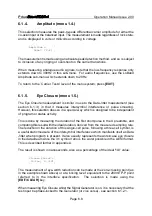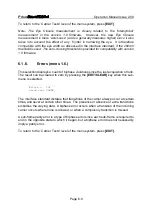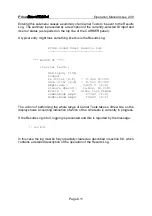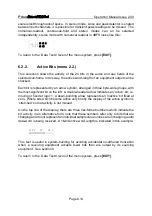
Prism
Operation Manual Issue 2.00
Page 5.4
For example, if the [DO] mode is set to 'RPT' and then [SYNC O/P] is set to 'REF' or
the Ref Learn menu is entered, the [DO] mode is over-ridden to 'loop-through' since the
PLL cannot be used for DO regeneration whilst locked on the Ref Sync signal. 'RPT'
mode is automatically reselected on exiting the over-riding mode, unless the [DO]
mode has been manually reselected in the mean time.
Additionally, selection of the 'FNC' mode is prevented during operation of some menu
functions (for example the Microscope) and conversely these menus cannot be entered
whilst the Signal Generator is switched on.
5.3.5.
SYNC O/P key
The [SYNC O/P] key controls the source of the `SYNC' test output (see section 3.5.).
In 'CHAN' mode, the SYNC pulse marks the start of the preamble for the A or B sub-
frame (the X- or Y-preamble), as selected by the [CHAN] key. In 'BLK' mode, the
SYNC pulse marks the Z-preamble at the start of each Channel Status block.
'REF' mode behaves like 'CHAN' mode, except that the SYNC pulse is referred to the
REF SYNC input. In this case, the DSA-1 automatically selects whichever REF SYNC
input is in use, and determines whether an IEC958/AES11 or Wordclock reference is
connected. In the latter case, the SYNC pulse is referenced to the rising edge of the
Wordclock.
The timing of the SYNC output is arranged so that its rising edge slightly precedes the
start of the selected preamble. This allows the whole preamble and following data to
be easily viewed on an oscilloscope. Note that when the DSA-1 Signal Generator is
in use and synchronised to DI, the sync pulse is slightly advanced with respect to the
DI data owing to internal timing constraints.
The [SYNC O/P] key may interact with some other functions, principally in that 'REF'
mode may be unavailable when certain menu or Signal Generator functions are active;
refer also to the note in section 5.3.4.








